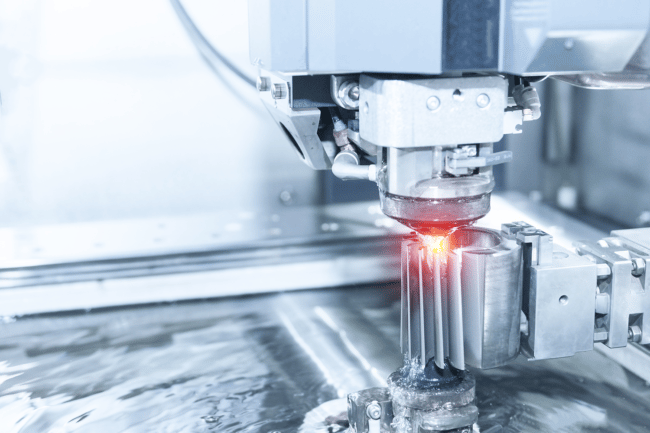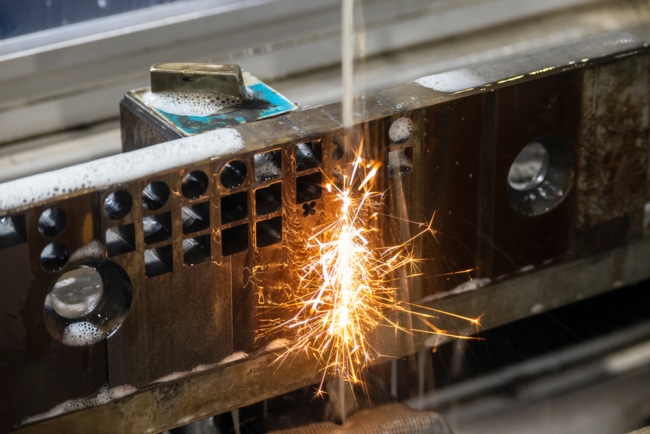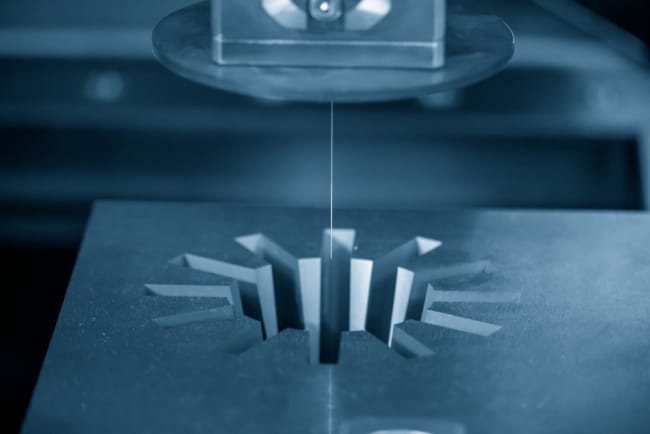Electrical discharge machining (EDM) has long been the answer for high accuracy, demanding machining applications where conventional metal removal is difficult or impossible.
Electrical Discharge Machining Basics
Electrical discharge machining (EDM) has long been the answer for high accuracy, demanding machining applications where conventional metal removal is difficult or impossible.
Known by many other names, including spark machining, arc machining and (inaccurately) burning, the EDM process is conceptually very simple: an electrical current passes between an electrode and a workpiece which are separated by a dielectric liquid. The dielectric fluid acts as an electrical insulator unless enough voltage is applied to bring it to its ionization point, when it becomes an electrical conductor. The resulting spark discharge erodes the workpiece to form a desired final shape.
Electrical Discharge Machining Basics from US engineering.com
https://www.engineering.com/AdvancedManufacturing/ArticleID/10100/EDM-101-Electrical-Discharge-Machining-Basics.aspx
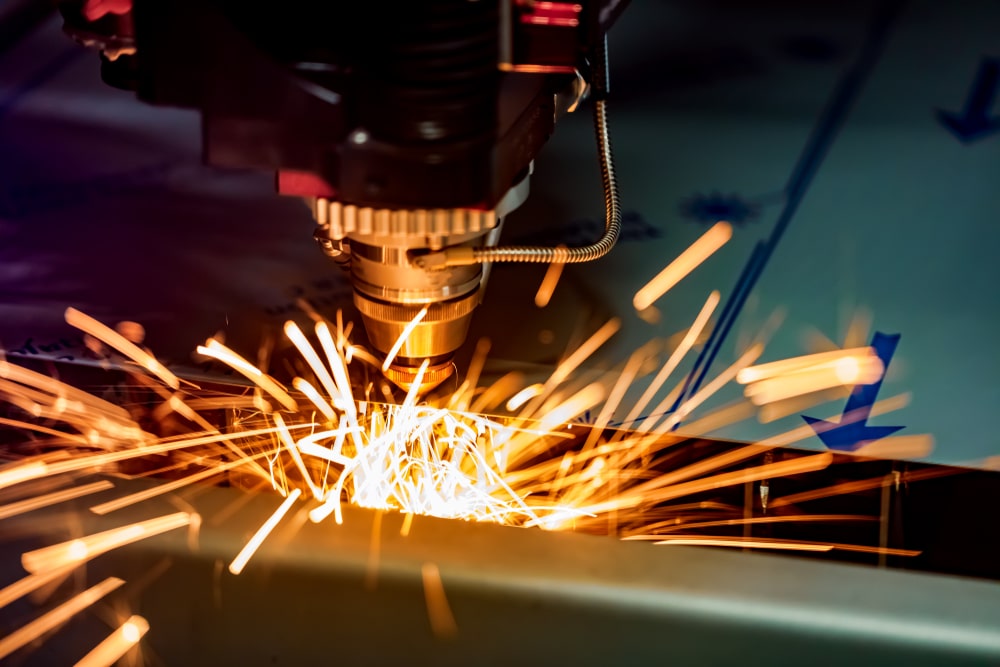
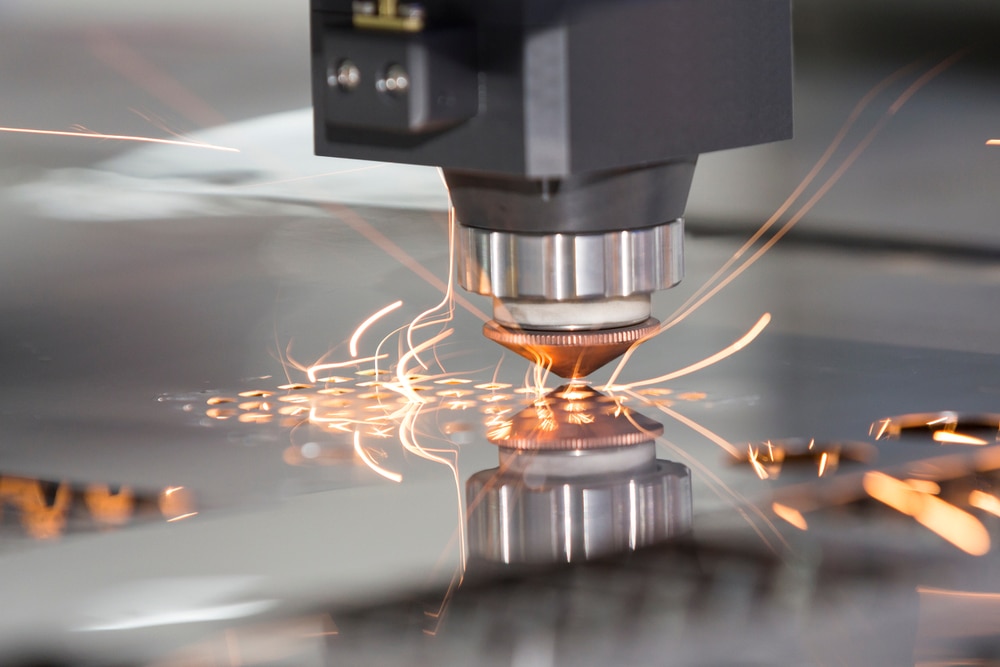
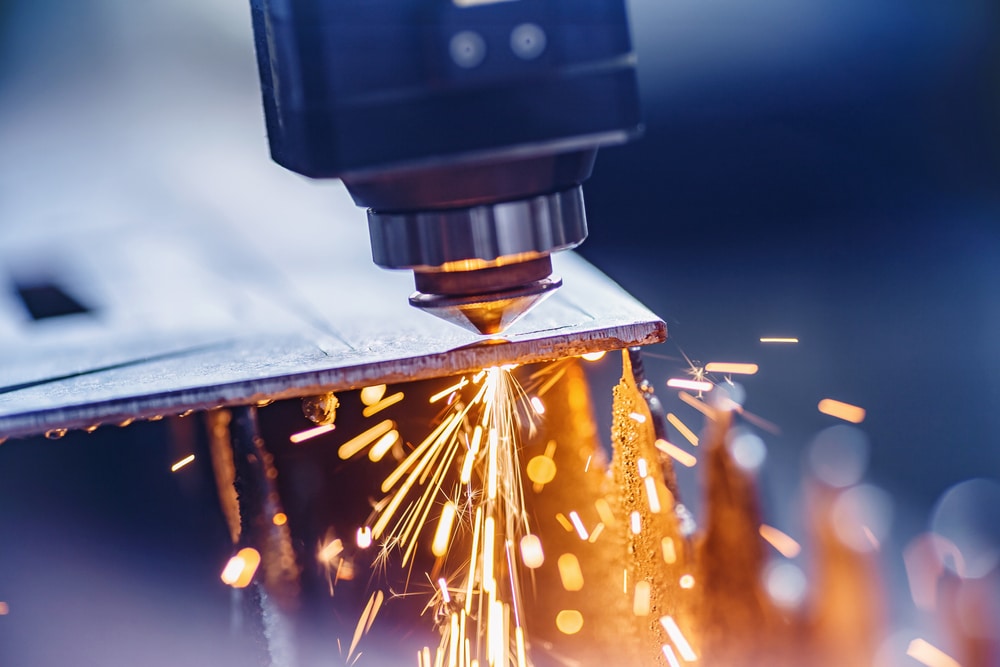
3 Types of EDM Machines
While there are many specialized forms of electrical discharge machining, industrial EDM machines are commonly grouped into three categories:
- Die Sinker or "Ram” EDM
- Wire or "Cheese Cutter” EDM
- Hole Drilling or "Hole Popper” EDM
All three types operate on the same principal of erosion by electrical discharge discovered by Joseph Priestley in 1770, but their history, methods and applications are notably different.
Die Sinker EDM
Like the electric telegraph and the jet engine, die sinker EDM was invented independently and almost simultaneously by more than one person. In 1941, Russian scientists Boris and Natalya Lazarenko were tasked with finding a way to increase the lifespan of tungsten breaker points. In the course of their research, they discovered that they could control the erosion of tungsten electrical contacts by immersing them in a dielectric fluid. By 1943, the Lazarenkos had developed a spark machining process based on this discovery that eventually became known as a resistor-capacitor (R-C) circuit for EDM.
At nearly the same time, an American engineering team—consisting of Harold Stark, Victor Harding and Jack Beaver—was working on a way to remove broken drills and taps. Harding, an electrical engineer, proposed using sparks to erode them away. The idea showed promise, but it wasn’t until water was added as a coolant that this approach became practical. Stark, Harding and Beaver continued to refine their process, which eventually became the basis for the vacuum-tube EDM, which made it possible to increase spark frequency from 60 times per second to well over 1,000.
As it exists today, die sinker EDM is used to create complex cavity shapes in tool and die applications, such as metal stamping dies and plastic injection molds. The die sinker process begins with machining a graphite electrode to form a "positive” of the desired cavity. This electrode is then carefully plunged into the workpiece, causing sparking over its surface as features close the sparking gap—the distance required for sparking.
Wire EDM
The history of wire EDM is less clear cut than die sinker EDM, but what is known is that it was developed over roughly a decade between the 1960s and 1970s as a new method for making dies from hardened steel. As the name implies, wire EDM uses a thin wire for an electrode. The wire moves in a carefully controlled pattern, roughly analogous to a woodworker’s scroll saw, causing sparking to occur between the wire and the workpiece. Because the electrical discharge erodes by the wire and the workpiece, wire EDM machines use a spool of wire that’s continuously moving to present a fresh discharge path in the cut.
This "cheese cutter” approach to EDM works well, but it has an important limitation: the wire must pass entirely through the workpiece, making an essentially two-dimensional cut in a three-dimensional part. Control of the wire’s movement in an XY plane on modern-day machines is similar to other CNC-driven technologies.
Hole Drilling EDM
The principle benefits of EDM—its excellent surface finish, minimal heat-affected zone (HAZ) and ability to cut hardened materials and exotic alloys—make it ideal for certain hole-making applications. If a small pilot hole is pre-drilled into workpiece, wire can be threaded through it to complete the operation using wire EDM.
Cases where this is impossible—blind hole applications, for example—call for a specialized EDM hole making machine. Commonly called a "hole popper” this machine uses a rotating conductive tube for its electrode and a continuous flow of dielectric fluid (usually deionized water) to flush the cut. Hole popper EDM can also be used to create the pilot hole necessary for wire threading.
The ability to create accurate and precise holes, even in hardened or exotic materials has been a key development for several advanced technologies, such as EDM-created cooling holes in high-temperature alloy turbine blade sections. This permits a "film cooling” process, which allows jet engines to operate at higher temperatures for greater durability and efficiency.
Dielectric Fluid
Die-sinker EDM machines typically use hydrocarbon oil for their dielectric fluid, into which both the workpiece and spark are immersed. In contrast, wire EDM machines normally use deionized water, into which only the sparking area is immersed. Whether oil-based or water-based, the dielectric fluid used in EDM machines serves three critical functions:
Controlling the spacing of the sparking gap between the electrode and workpiece. Cooling the heated material to form the EDM chips
Removing EDM Chips From the Sparking Area
Although they’re considerably smaller than those produced in milling or turning processes, EDM does produce chips. These tiny, hollow spheroids are composed of material from both the electrode as well as the workpiece. Just like any chip, they need to be removed from the cutting zone, which is accomplished by flowing the dielectric fluid through the sparking gap.
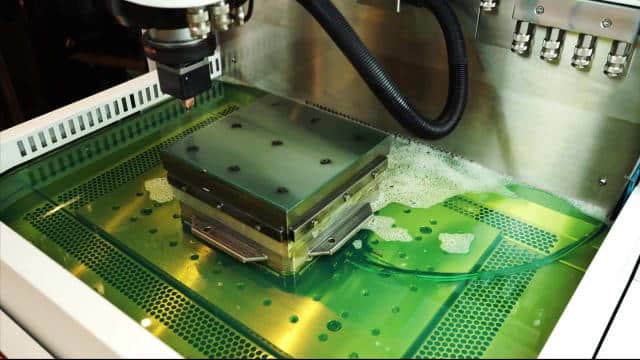
Dielectric Fluid Lifespan
As the dielectric fluid breaks down—whether as the result of age or contamination—the risk of unstable discharge increases. Control electronics can compensate to a certain extent, but the only real solution is to continually pump clean dielectric fluid through the cutting zone to flush it. The more conductive particles in the fluid, the more difficult it is for the machine to maintain stable electrical thresholds inside the sparking gap.
Because the lifespan of dielectric fluid depends on a host of factors, such as its type and the efficiency and quality of your EDM fluid filters, it has no definitive expiry date. As a rule of thumb, however, if you’re using a oil-based fluid and it’s over five years old, it should probably be replaced. You can also perform sight and smell comparisons between used and virgin fluids, but the best way to determine whether your dielectric fluid needs to be replaced is with a refractometer.
Selecting Dielectric Fluid Type
Choosing the right dielectric fluid for your EDM application is not always as straightforward as it might seem. Many criteria need to be taken into account. Some are obvious, such as degree of metal removal and electrode wear, while others are much more subtle.
For example, particle suspension is a key property for machining efficiency, since the fluid needs to be able to remove EDM chips and other waste particles from the cutting zone. However, if particle suspension is too high, these impurities will not separate from the fluid during filtration.
To ensure that you’re using the best dielectric fluid for your particular machine, consult its manufacturer.
EDM Materials
Obviously, any workpiece that’s going to be machined with EDM has to be electrically conductive, but there’s more to the material limitations of electrical discharge machining than that. For one, certain materials, such as high-nickel alloys—like those found in the aerospace industry—and carbide materials can present a greater challenge for EDM compared to standard tool steels. However, the solutions to the material issues in these cases lie in variations of electrode materials and slower EDM cycle times.
Moreover, while EDM is technically a stress-free machining process—since no direct mechanical force is applied to the workpiece), it’s still a thermal process and so has the potential to alter the metallurgy of the workpiece via heat affected zones (HAZs), recasts and micro-cracking.
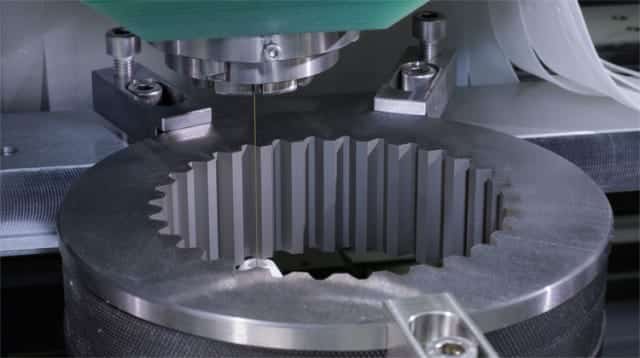
Heterogenous Materials
"Most EDMs from the year 2000 on are capable of producing excellent metallurgical quality thanks to the advancement of EDM technology and adaptive power controls,” said Brian Pfluger, EDM Product Line Manager at Makino.
Of course, some electrically conductive materials still don’t play well with EDM. "I’ve been asked to cut silicon wafer material, which is almost glass-like,” said Greg Langenhorst, Technical Marketing Manager at MC Machinery. "That doesn’t work too well: it’s way too brittle and the spark energy just shatters it like glass. Some of it is conductive enough that you can cut it a little bit, but not very well.”
Heterogenous materials, especially those with impurities, can also present a problem for EDM, as Langenhorst explained:
"With carbon fiber composites, even though they are electrically conductive, the adhesives in them create some problems because they’re non-conductive. I’ve even run into that when someone buys cheap tool steel. When it has a lot of particulate—I call it ‘melted car bumpers’—that’s non-conductive, if you hit one of those, it’s like hitting a stone: you just can’t get through it.”
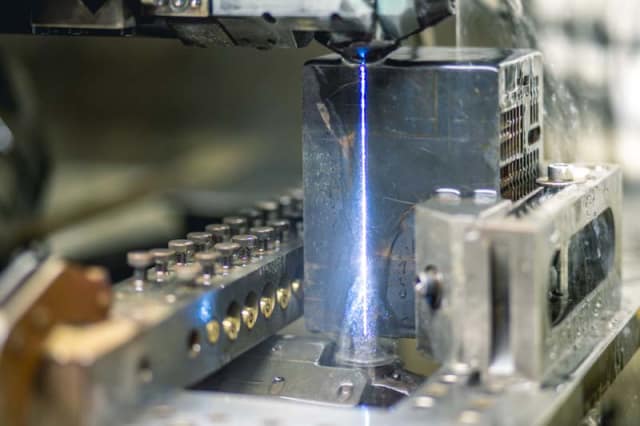
Why Use EDM?
In practical terms, electrical discharge machining overcomes a major issue found in contact machining: hardness. In traditional processes, metal workpieces are made from special grades of hardenable tool steels machined in an anneal of soft state to facilitate cutting.
One the desired shape has been machined, the parts are then hardened by one or more heat treatments. This adds time, cost and can alter the finished parts’ dimensions, especially if the heat treatment process is not properly controlled. The advantage of EDM is that it can cut hardened materials and exotic alloys while also providing excellent surface finishes as a bonus. The result is often a reduced need for post-processing or surface treatment.
Like all machining processes, EDM requires a balancing act between speed and surface finish. In wire EDM, for example, it’s common to use faster, rougher cuts followed by finishing or skimming cuts that use a less aggressing flushing profile to minimize wire deflection. Sinker EDM sees a similar pattern, with most jobs using two electrodes: one for roughing and one for finishing.
"With sinkers, there’s a standing joke that you don’t want to use a sinker EDM unless you absolutely have to: if there’s no other way to get the shape you need into the part,” said Langenhorst. "Over the years, sinkers have become less and less utilized because of high-speed hard milling. As that process improved, there’s less sinker cavity work that needs to be done. The areas you can’t do with hard milling are sharp inside corners or very deep, thin ribs. That’s where sinker EDM is a must.”
Advantages of EDM
The principle advantages of EDM are that the process is very predictable, accurate and repeatable. "All EDM machining is performed unattended, so the direct labor rate and manufacturing cost are typically lower for EDM than other methods,” said Pfluger. "In general, the EDM process is reserved for parts with smaller feature sizes and higher accuracy requirements (+/- 0.0005” or +/--0.012mm or finer accuracy).”
"Once you have a wire EDM in your shop, it becomes very obvious that you can do a lot more with it than just what you bought it for,” said Langenhorst. "All of a sudden, they realize that can cut strippers, knockouts, die buttons, inserts, slides, all kinds of parts. If you need to do die tryouts on a form die, you can actually cut the sheet metal blanks to test the form die.”
Electrical Discharge Machining vs. Other Machining Processes
"There’s more than one way to skin a cat,” as the old expression goes. Similarly, there’s typically more than one way to cut parts. Compared with conventional machining—from basic CNC turning all the way up to 5-axis—EDM has certain advantages and disadvantages. So, if you’re wondering whether EDM is the best bet for your particular application, the answer is always the same: it depends on your application.
Generally speaking, however, the principle characteristics of electrical discharge machining should give you a sense of whether EDM is a good fit for your application. For example, EDM is typically slower than other machining methods, but it also tends to be more predictable, accurate and repeatable. There are other benefits as well, as Pfluger pointed out: "All EDM machining is performed unattended,” he said, "so the direct labor rate and the cost of manufacture with EDM are typically lower than other methods.”
The combination of predictability, accuracy and repeatability—combined with its relatively slow machining speed—explains why EDM is most at home in low-volume operations with tight tolerances, such as the aerospace and medical device industries.
"The biggest point in favor of piece part manufacturing with wire EDM is when you get into part detail and you’re trying to do it with a slitting saw or a grinder, or any type of friction machining, which is going to create a burr,” said Langenhorst. "In that case, you have to have a secondary process for burr removal, whether it’s vibratory or having a bunch of workers scratching the burrs off with hand tools. On the other hand, when you take a part off an EDM machine, there is no burr: it’s perfect.”
Pfluger pointed out another advantage to using electrical discharge machining for parts with small or complex features: "The EDM process becomes more attractive as workpiece materials become harder, and as the part geometry becomes smaller and deeper,” he said. "Unlike conventional milling, EDM does not encounter limitations with L:D as internal radii features become smaller and workpiece thickness increases. In general, the EDM process is reserved for smaller part feature sizes and higher accuracy requirement applications (+/- 0.0005” or +/- 0.012mm or finer accuracy).”
Moreover, since EDM is a non-contact machining process, the fixturing requirements for cutting small parts are considerably less onerous compared to those of a standard CNC mill. "There’s no cutting pressure, so if you’re working with little tiny pieces, you don’t need much of a fixture to hold them,” said Langenhorst. "If you tried to mill them, have you to have it held tight enough that your machining process won’t pick it up or bend it. For example, if you’re doing core pins for molds and you try to grind them, they’ll move all over the place. You can wire cut those with just a 90-degree flip fixture and they come out great.”
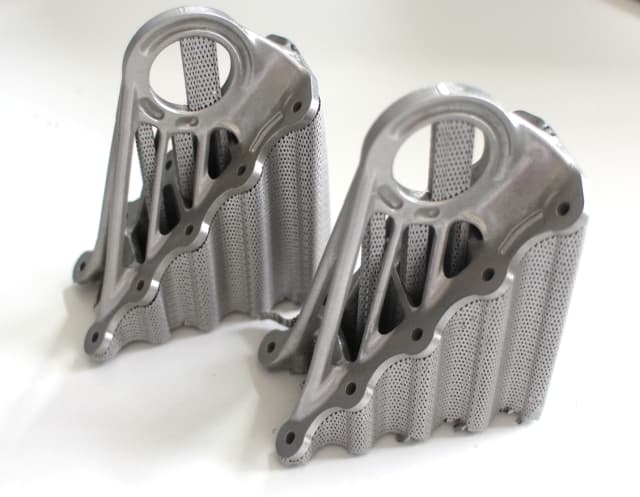
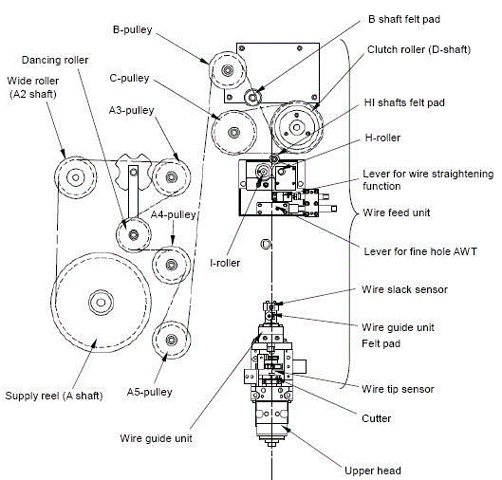
EDM & Additive Manufacturing
Anyone who’s been paying attention to manufacturing technology over the last decade or so knows there are some big changes coming. Often presented under the banner of Industry 4.0 or the fourth industrial revolution, the conjunction of various technologies, including robotics, artificial intelligence and the Industrial Internet of Things (IIoT)—will forever change the manufacturing sector, from machine tools to quality assurance.
Additive manufacturing is one of the most frequently cited examples of an Industry 4.0 technology, one which could potentially replace so-called subtractive processes (like EDM) entirely. Interestingly, both Langenhorst and Pfluger see additive and EDM as more complimentary than competitive, as Langenhorst explained:
"The biggest thing with metal additive manufacturing is that you have to build on a base plate and then separate the part from that,” he said. "Depending on the complexity of the attachment layer, it can be a pain to separate them.
Conclusion
In conclusion, laser welding is a highly efficient and precise method of joining materials together. It offers several advantages over traditional welding techniques, including minimal heat distortion, high weld quality, and the ability to weld complex geometries. Laser welding is widely used in various industries such as automotive, aerospace, electronics, and medical devices.
Related Content
Need more information?
To see how A&M could support your next complex manufacturing project – simply call us, or use the form below.
